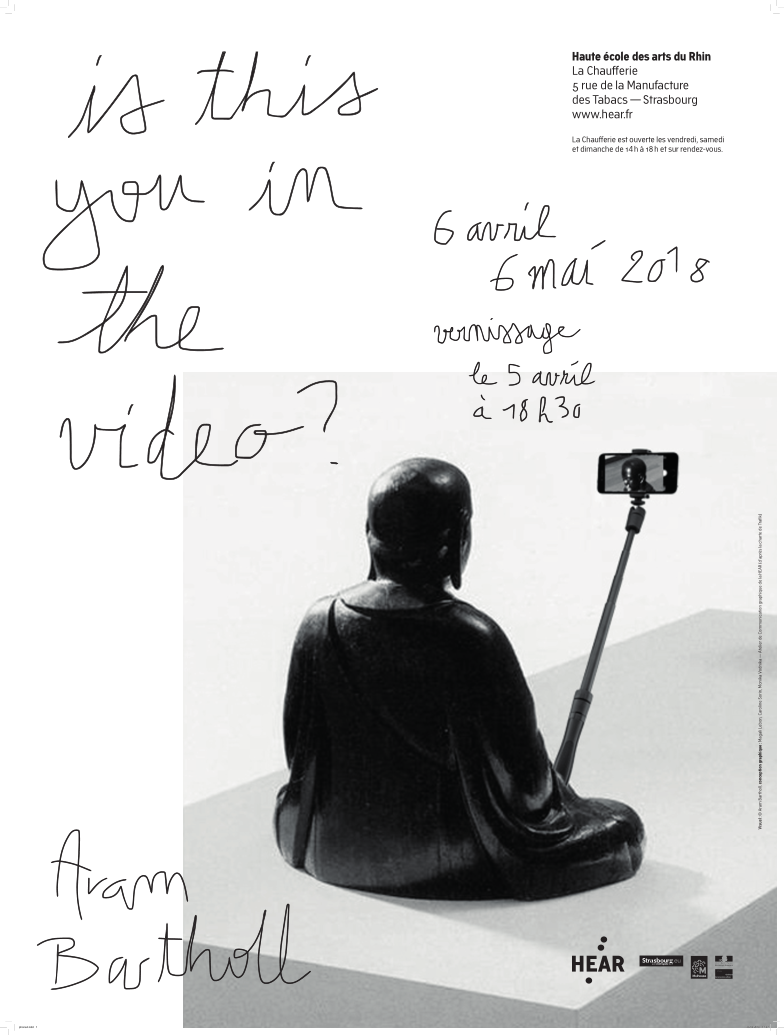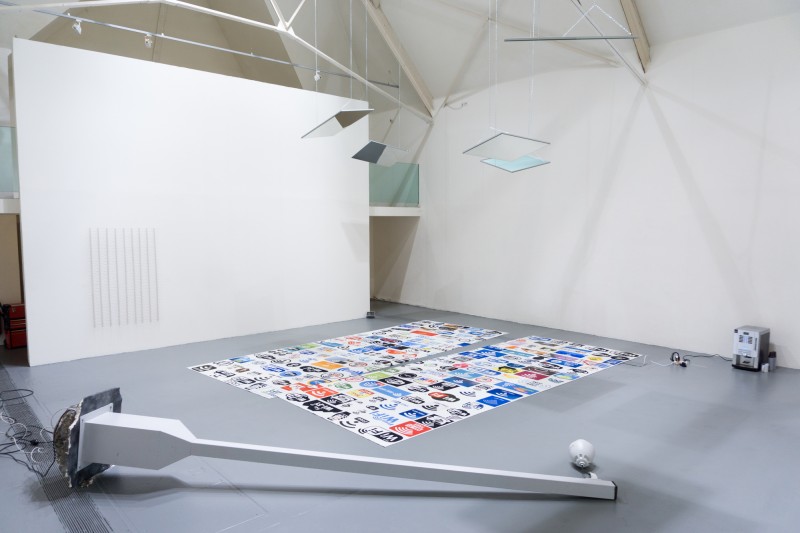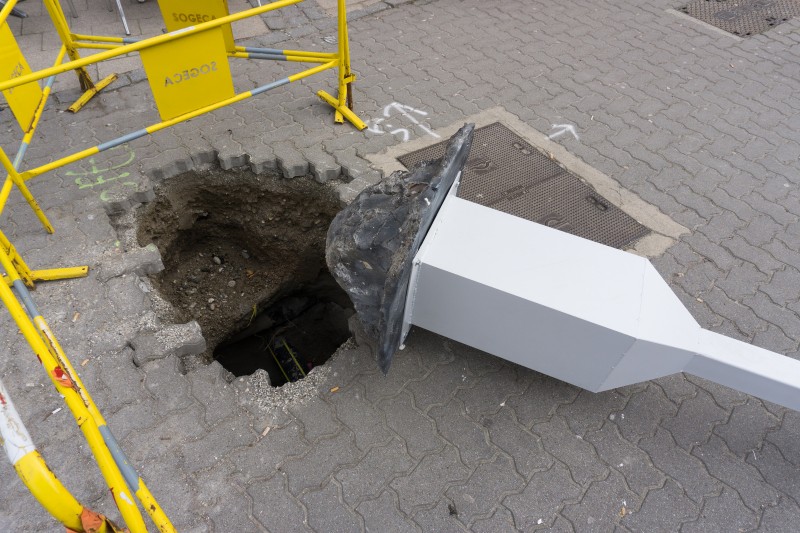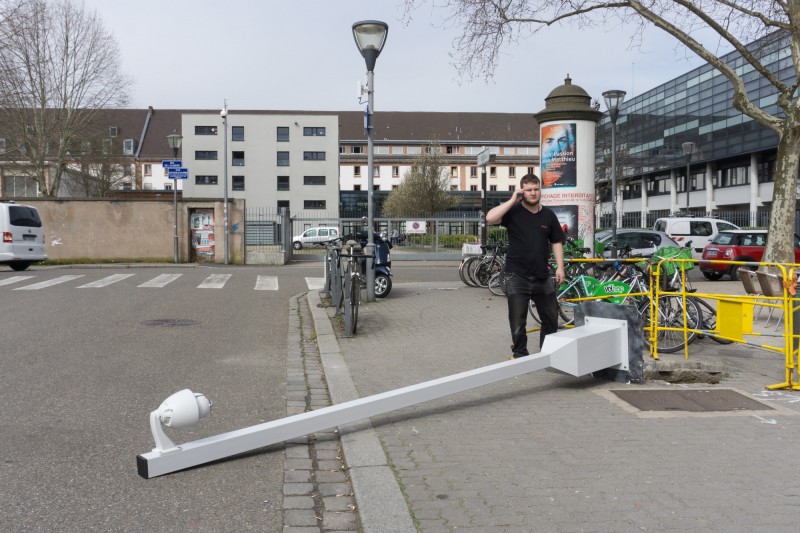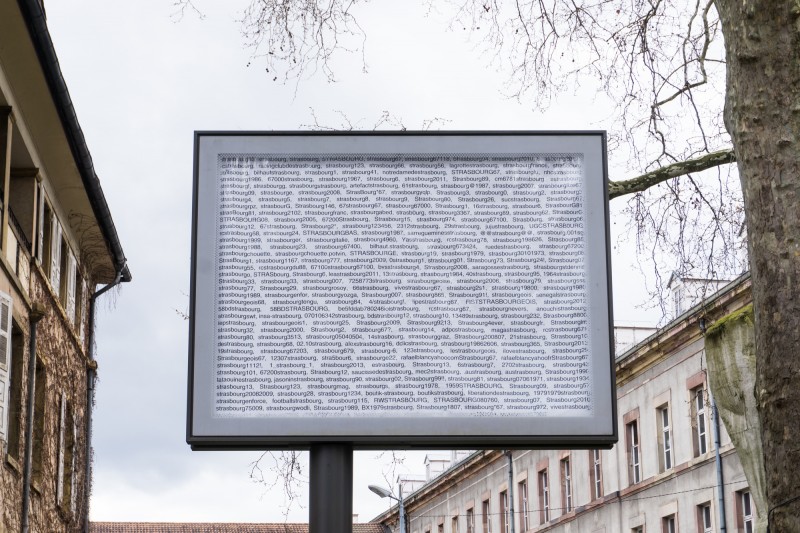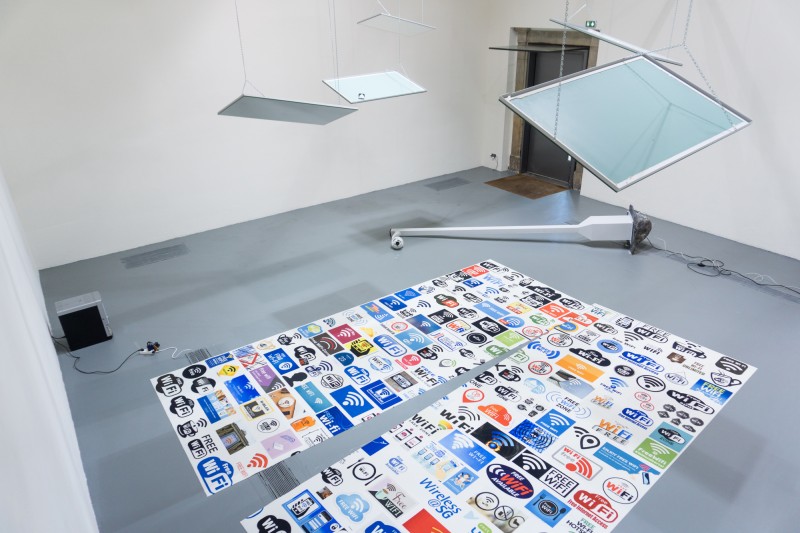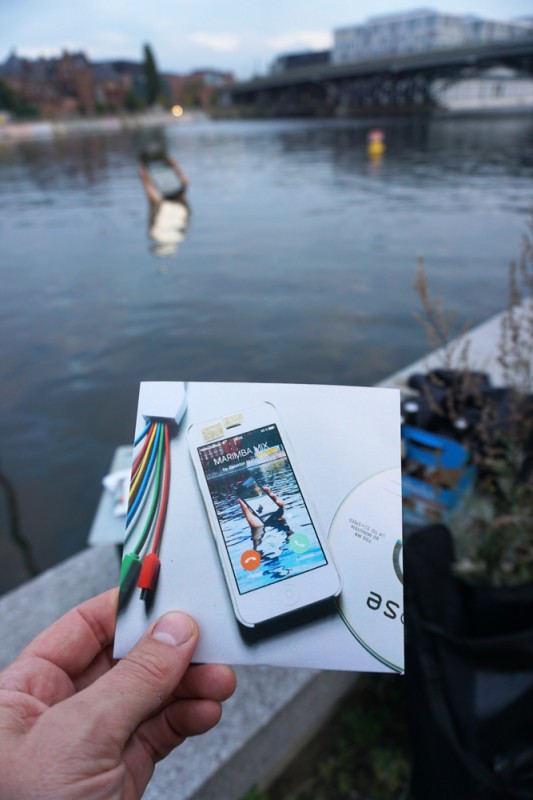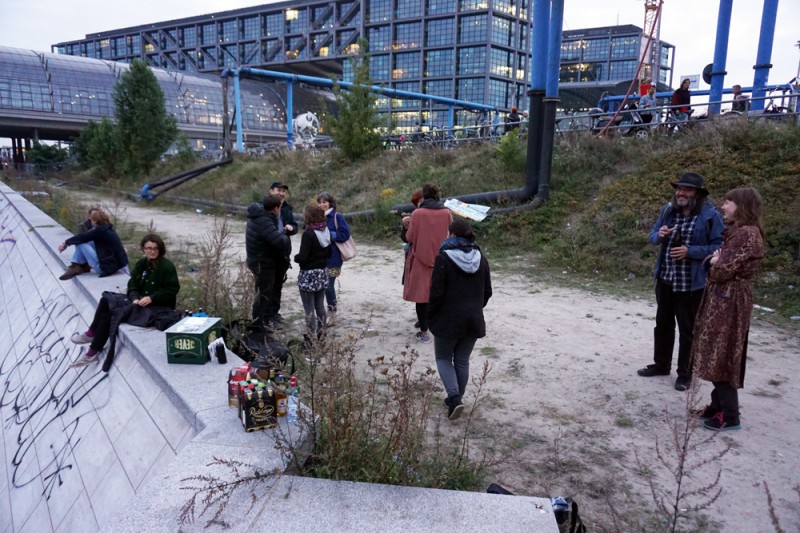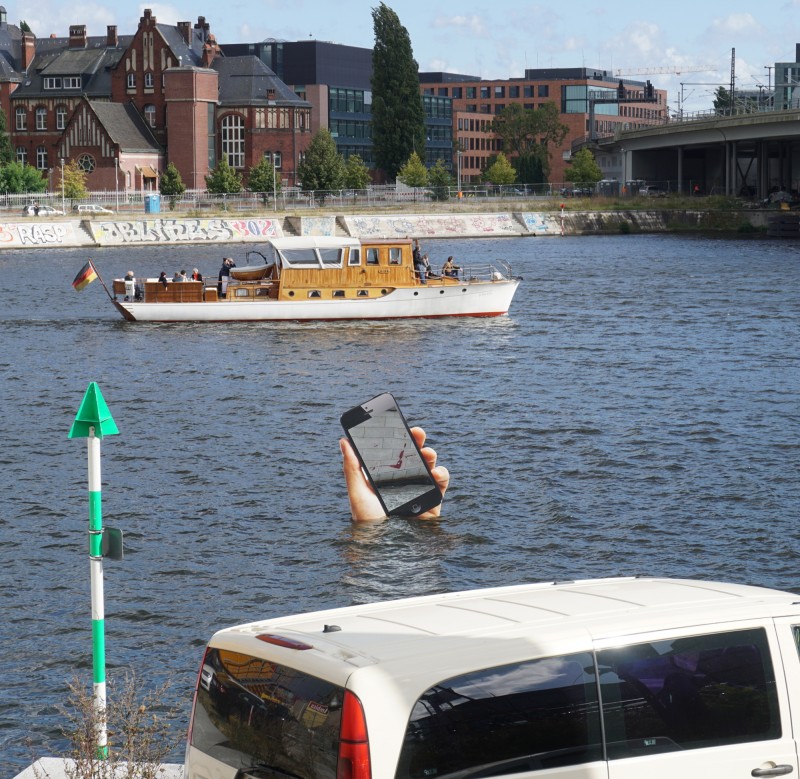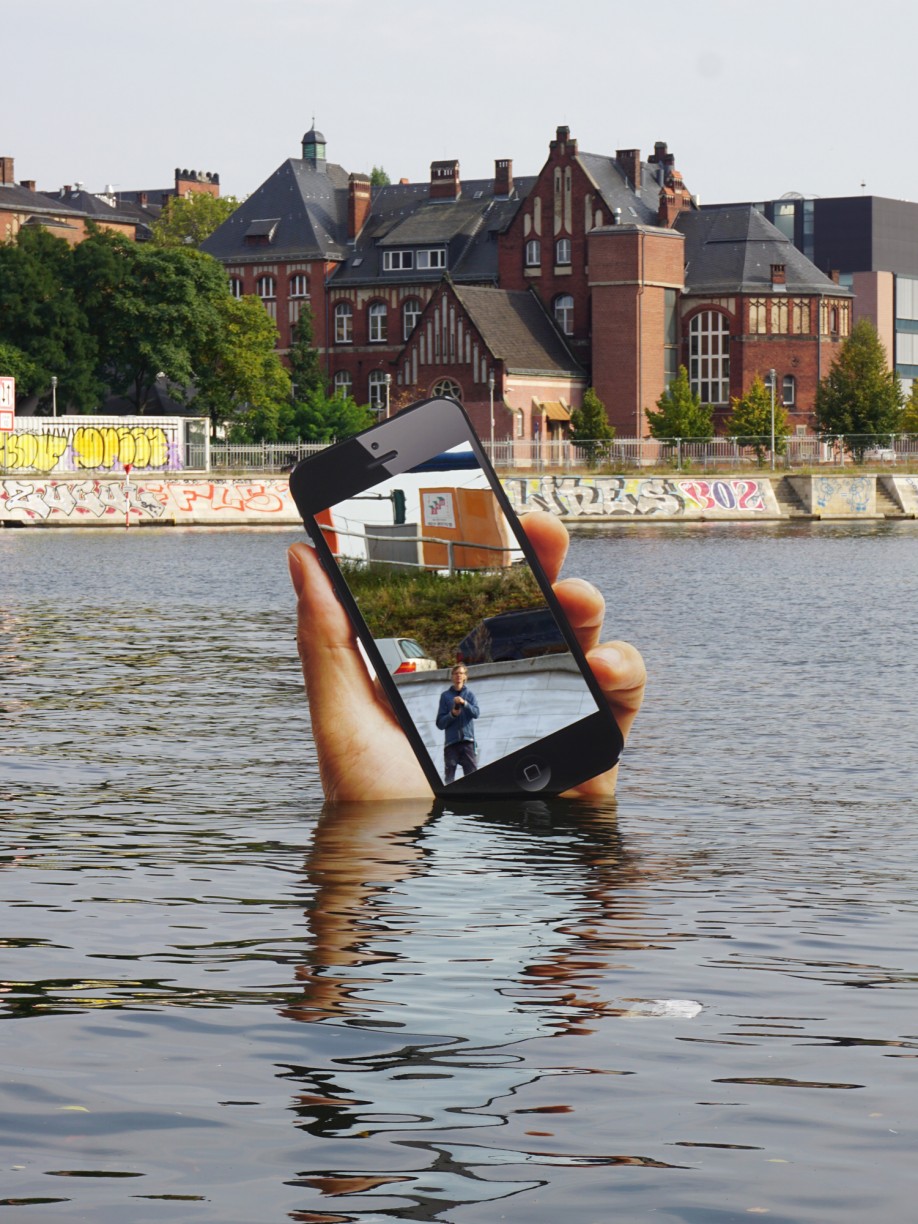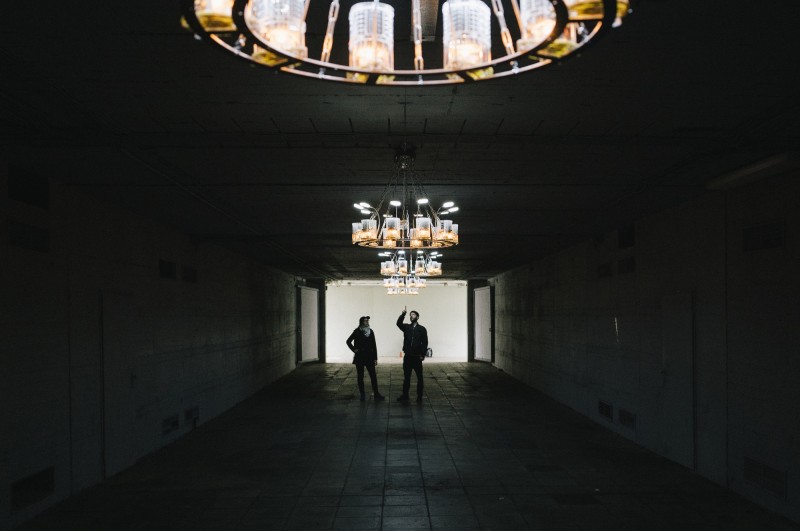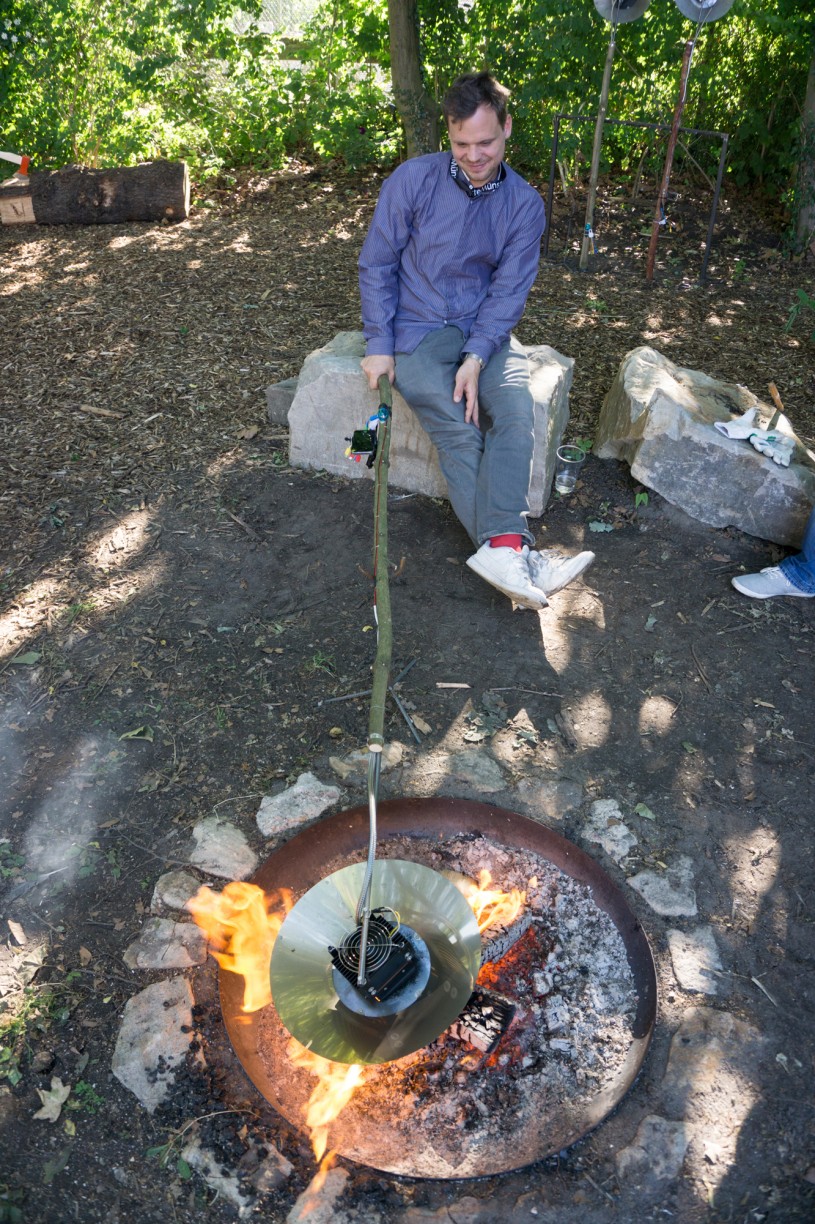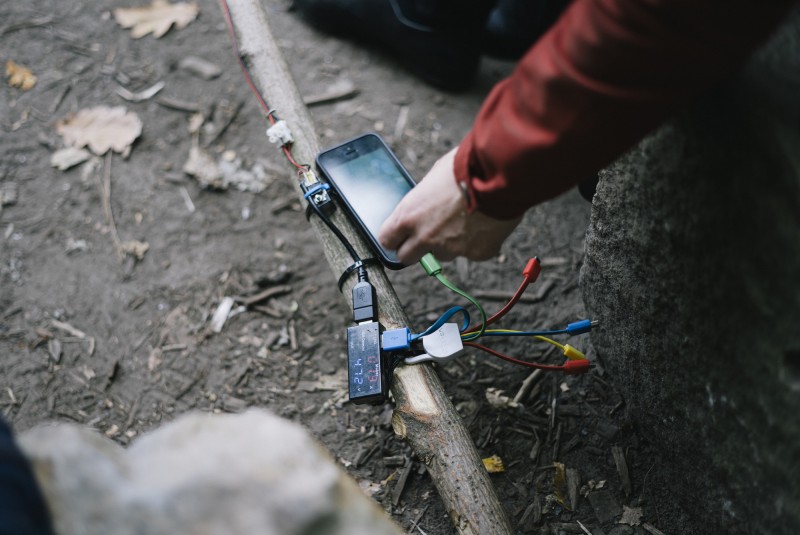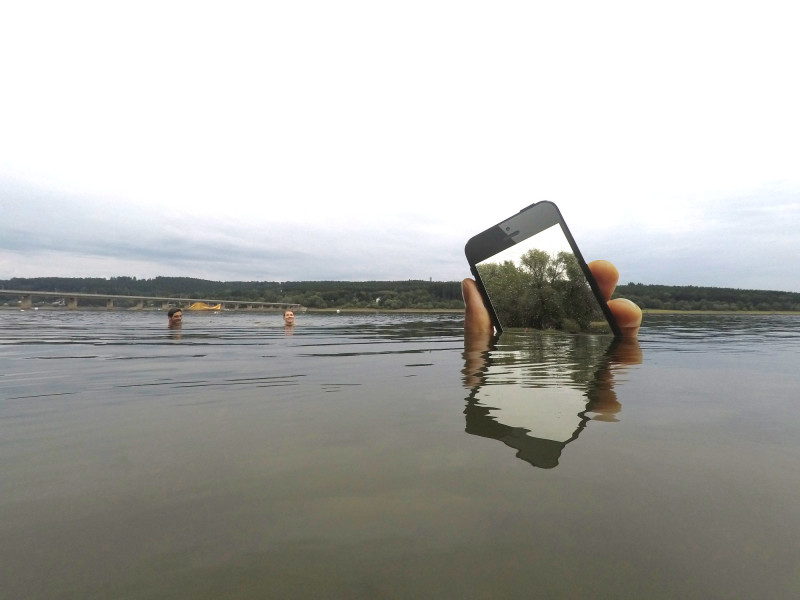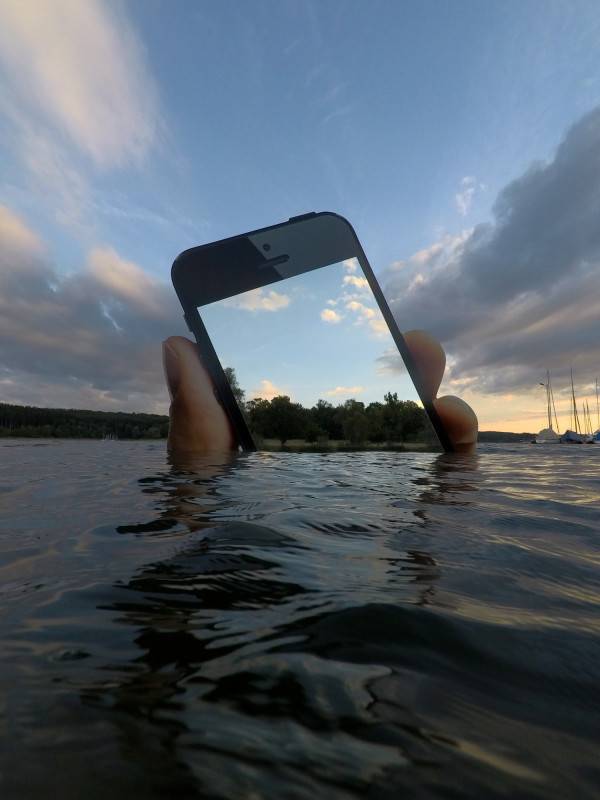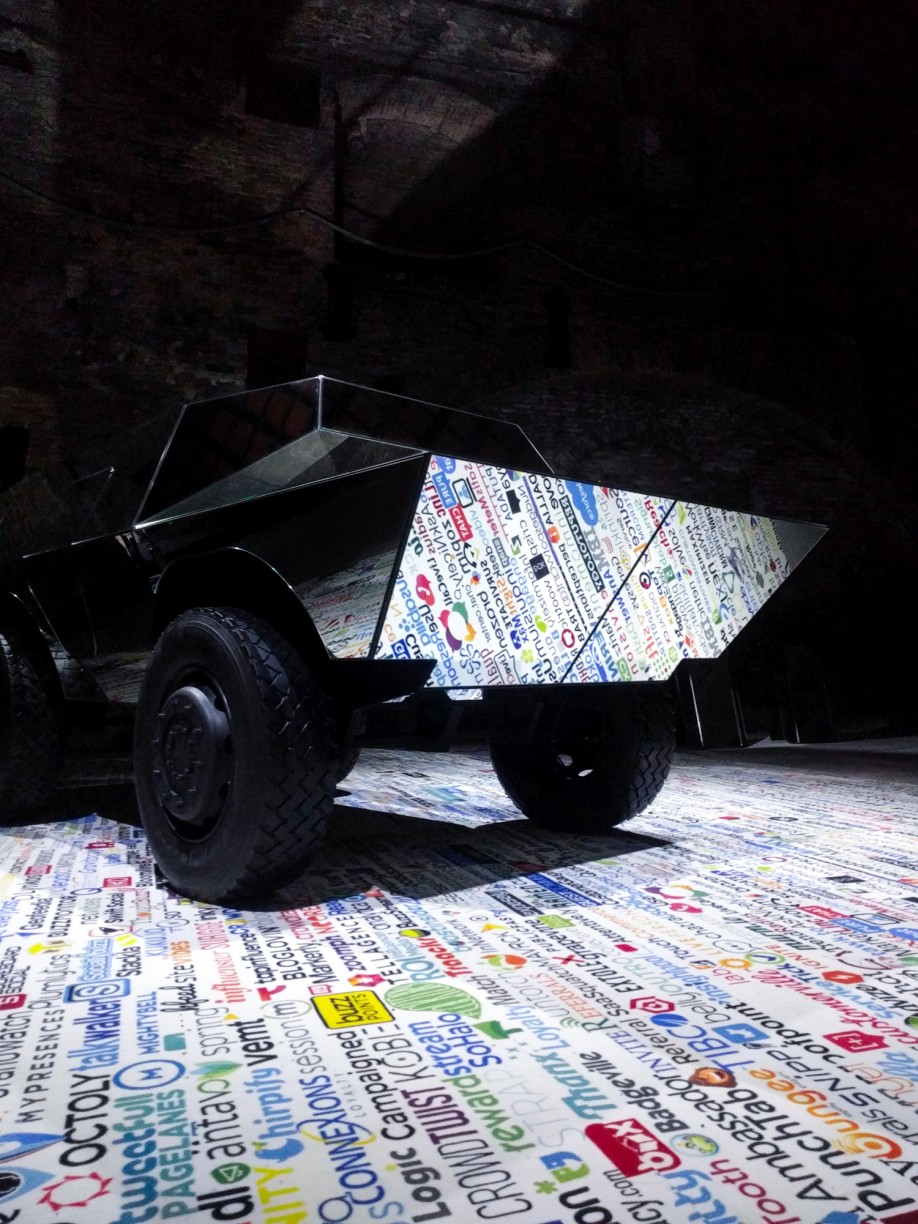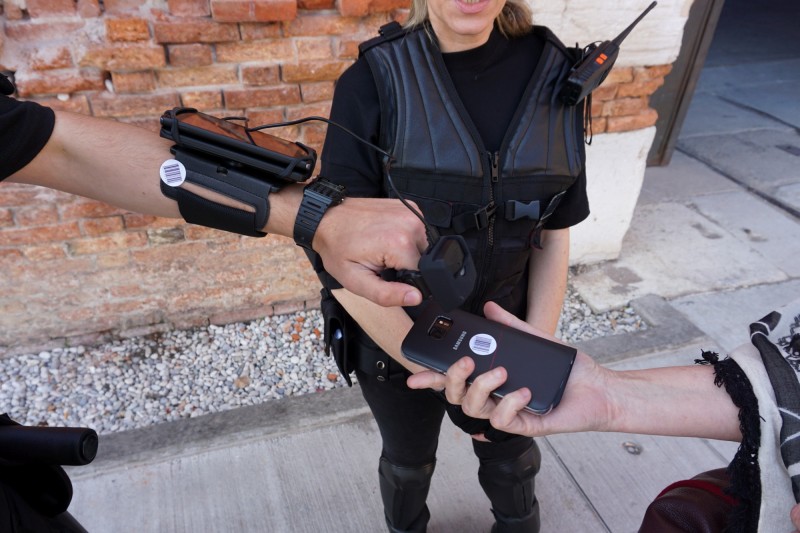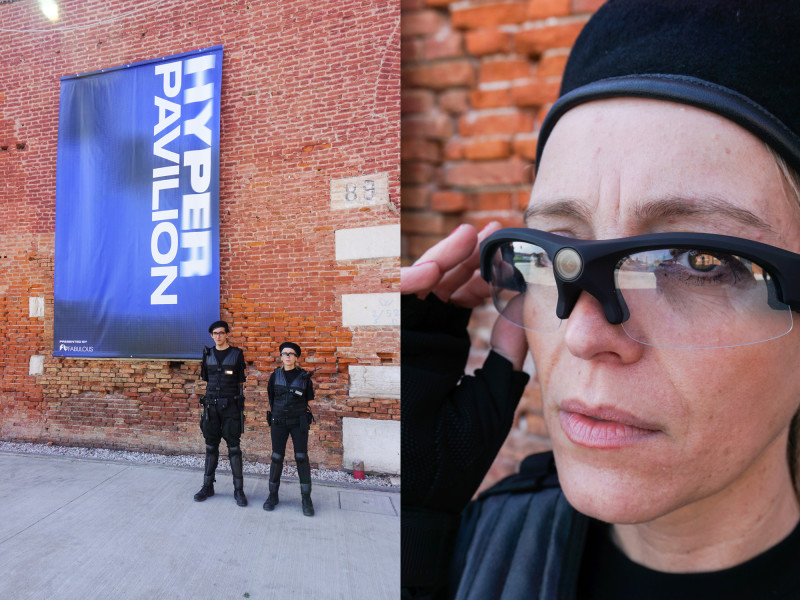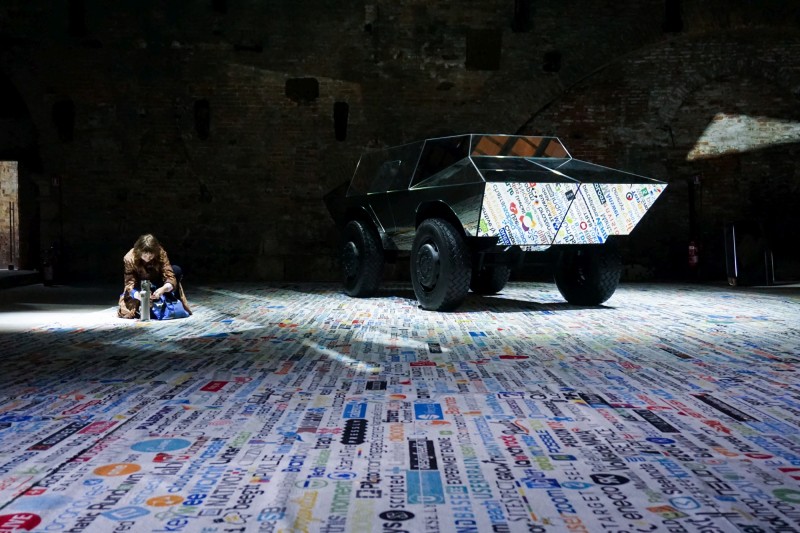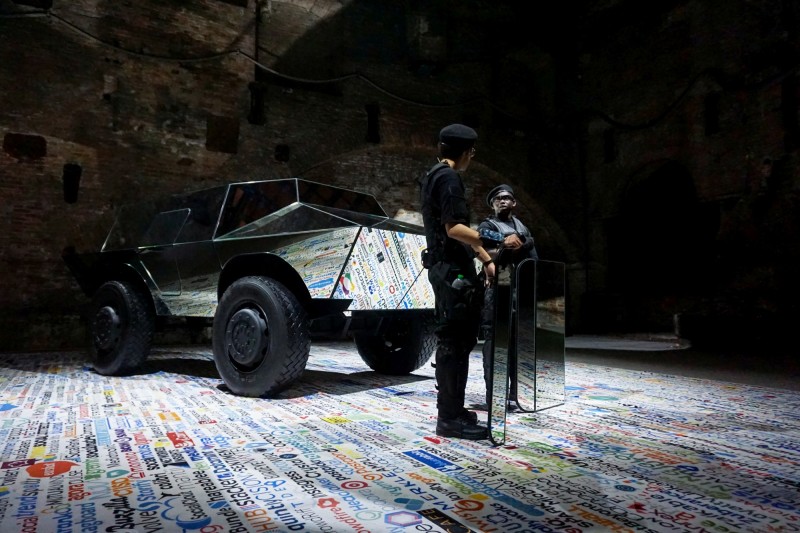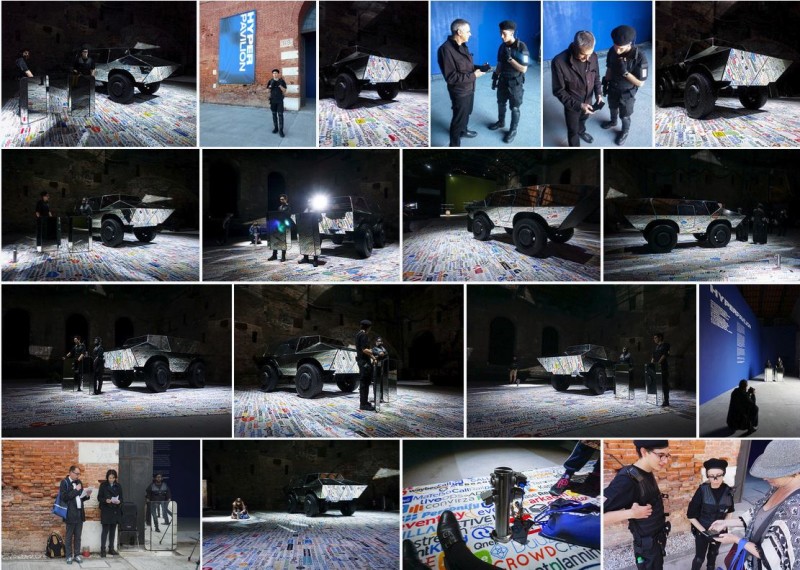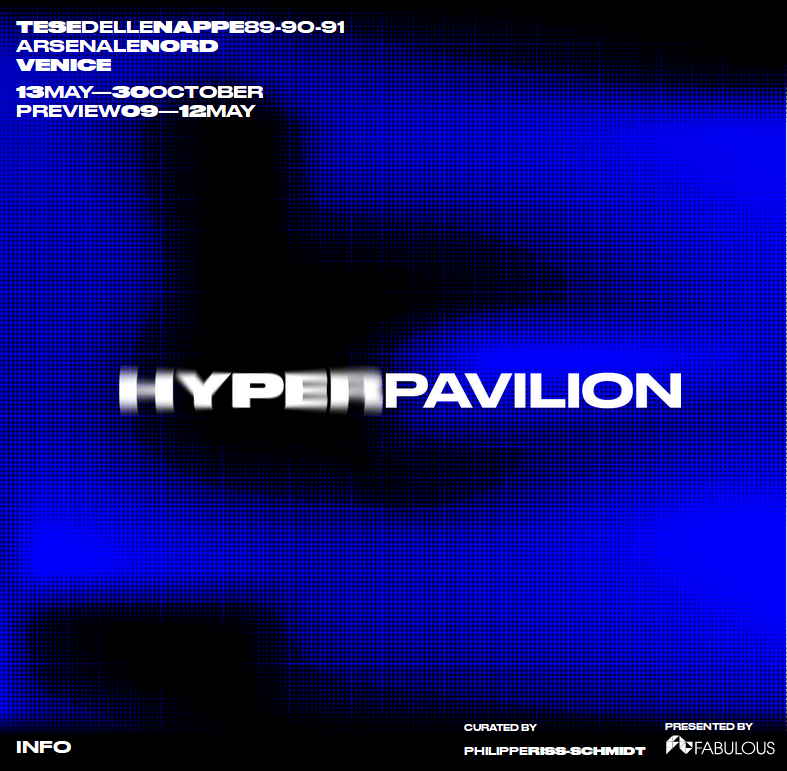Archive for the ‘uncategorized’ Category
This is my old blog!! New posts at -> http://arambartholl.com/news/
This is my old blog from back in the days when blogging was a cool thing ;)) Things moved to my new website but everything here will stay online. New blog posts can be found at arambartholl.com/news
Is this you in the video?
Is this you in the video?
Solo show, Aram Bartholl
Gallery Chaufferie, H.E.A.R., Strasbourg
New works!
April 6 — May 6, 2018
Opening April 5, 7:00 pm
While Facebook apologizes to the world from high up on its mountain of data, 1.4 billion user passwords party naked on the Internet. Research has shown that the ‘123456’ is used for 17% of all passwords. There is so much free WiFi in the air to catch you, it is almost impossible to get online. But there is coffee, so you stay for the deep pocket packet inspection of your traffic.
Is this you in the video? Don’t click the link I sent you!
Like the pigeons’ best friend, CCTV cams squat in every high corner of the city protecting us from the future. Will they fall off or be released from their stoical non-presence? A total of 750 info screens have been removed from the still closed / never opened BER airport in Berlin because the technology is outdated. The screens had been running for six years straight without anybody ever having looked at them.
Yes, I saw this already.
Please place all your bags on the left tray. Mirrored self-checkout in an uberficial life without cueing is on autoplay. 24 likes. Thank you for being our customer today.
April 6 – Mai 6, 2018
HEAR, La Chaufferie
5 rue de la Manufacture des Tabacs
Strasbourg, www.hear.fr
All pictures at https://www.flickr.com/photos/bartholl/sets/72157689720740210/
Don’t show again
Group show by the class New Media, Prof. Aram Bartholl, Kunsthochschule Kassel.
pic by sighpoutshrug
Don’t Show Again!
Constant alerts, requests, and notifications keep us immersed in information flowing daily across our screens. Little windows appear at the monitor’s edge and jump onto smartphone taskbars; milky overlays interfere with viewing entire web pages.
It is down to attention. User attention is now the most valuable commodity on the Internet. The online advertising industry is in real crisis. Only the biggest advertising monopolies–Google and Facebook–can still benefit from advertising revenue, while all others are left with nothing. Social media networks are saturated, user numbers are stagnating; there is an increasing fatigue with liking, sharing and posting because too many services, news items, and friend requests are competing for our attention. It seems as if faith in what is presented to us on screens is diminishing. “That’s fake” is the new standard. A limited number of meme-like headlines get global attention while important issues sink without a trace. We spend on average up to three hours a day on smartphones only to ask ourselves later what we actually achieved.
New Media students of Kunsthochschule Kassel deal with questions of attention, identity, and the use of media in a variety of ways. How do images and topics appear and spread through the Internet? What role does the screen play as a limit to understanding, and how will automation continue to change society? Overcoming the post-digital regime of attention will require new ideas and concepts that the technology-centered efficiency logic of internet platforms can never provide.
Participating Students:
Nicole Brauer, İpek Burçak, Echo Can Luo, Christopher Casper, Hannes Drescher, Stefan Endres, Robin Höke, Mike Huntemann, Saskia Kaffenberger, Jonas Leichsenring, Naima Omari, Didem Sandıkcı, Mario Strahl,
Video program: Lucie Friederike Müller, Jacob Höfle, Lisa Dreykluft, …
http://dontshowagain.online website by Stefan Endres
Reaktor, Wien
Vernissage: 19. Februar 2018, 19:00 Uhr
Öffnungszeiten: 20. Februar 2018, 10:00 – 16:00 Uhr
Geblergasse 40, 1170 Wien
https://www.reaktor.art/
(german version)
Don’t Show Again!
Ständig wiederkehrende Warnungen, Nachfragen oder Benachrichtigungen beschäftigen uns kontinuierlich bei der täglichen Informationsaufnahme am Bildschirm. Kleine Fenster erscheinen am Monitorrand, springen in der Smartphone-Taskleiste auf und milchige Overlays versperren die Sicht auf ganze Webseiten.
Es geht um Aufmerksamkeit. Die Aufmerksamkeit des Users ist heutzutage das höchste Gut im Internet. Die Online-Werbebranche befindet sich dabei in einer handfesten Krise. Nur die großen Werbemonopole Google und Facebook können noch von Werbeeinnahmen profitieren, alle anderen gehen leer aus. Viele Social Media Networks sind gesättigt, Nutzerzahlen stagnieren, eine allgemeine Müdigkeit zu liken, zu teilen und zu posten macht sich breit. Denn zu viele Dienste, Nachrichten und Freundschaftsanfragen konkurrieren miteinander. Es scheint, als wenn der Glaube an das, was uns auf dem Screen präsentiert wird, schwindet. „Das ist doch fake“ ist der neue Standard. Einzelne wenige Headlines mit Memecharakter erreichen weltweite Beachtung, während wichtige Themen untergehen. Wir verbringen tagtäglich im Schnitt bis zu drei Stunden am Handydisplay und fragen uns am Ende, was wir dort eigentlich getan haben.
Die Studierenden der Klasse Neue Medien der Kunsthochschule Kassel beschäftigen sich in vielfältiger Weise mit all diesen Fragen um Aufmerksamkeit, Identität und Mediennutzung. In welcher Art und Weise entstehen und verbreiten sich Bilder und Themen im Netz? Welche Rolle spielt der Screen verstanden als Grenze und wie wird Automatisierung unsere Gesellschaft weiter verändern? Das post-digitale Regime der Aufmerksamkeit zu brechen, erfordert neue Ideen und Konzepte. Die technikzentrierte Effizienzlogik der Internetplattformen wird diese nicht liefern.
Marimba mix release party!
*MARIMBA MIX* release PARTY!!
New MIX by Selector NUTTENDORF
Thursday Sept.21, 18:00 – 20:00, Afterwork-Sunset-Party!
Location Outdoor! Humboldthafen, Berlin -> HERE!
MARIMBA MIX is the finest Collection of Songs based on the pre-installed iphone ringtone, worlds most famous ringtone now a days, selected by Selektor NUTTENDORF. The Marimba ringtones’ origin is based on a percussion instrument called Marimba, similar to a Xylophon. It is the national instrument of Guatemala. MARIMBA MIX is developed in the Presence of Aram Bartholl’s artwork ‘Obsolet Presence’ as seen in the cover. The art piece was installed @Humboldthafen in Berlin for one month in September 2017. The MARIMBA MIX released on the 21.09.2017 as an irl CD.
—————————————————-
UPDATE:
The party was a great success!! The mix is for DOWNLOAD available at http://nadjabuttendorf.com/marimba-mix/
‘Obsolete Presence’ at Futurenows, Berlin
Obsolete Presence
at Festival of Futurenows, Hamburger Bahnhof, Berlin
14. – 17.9.2017
After the install at Möhnesee Obsolete Presence is currently shown in Berlin during the Futurenows festival. It is setup right next to Hauptbahnhof (central station) at the Humboldthafen. The piece will be up till October 10th.
Credits: Wasser- und Kulturbau GmbH Hönow, Thx!
3V / 5V / 12V
Skulptur Projekte Münster 2017
10.6. – 1.10.2017
I am showing three new works at Skulptur Projekte Münster this summer. Thermo generators which convert the heat of the fire directly into electricity play a central roll in these site specific works. Fire, in fact the first human technology serves as a power source for modern electronics and as catalyst for human communication. It was very much fun developing these new works for Münster in the past couple years. Skulptur Projekte has a faboulus team! I want to thank everyone in the production and the curatorial team very much! Please go and see the show. It is very good! Still up till 1st of October.
Aram Bartholl, 2017
3V
3 V
Material: Aluminium, acrylic glass, thermoelectric generator, electronics, LEDs, tea candles, steel chain
The otherwise closed pedestrian tunnel which leads to the castle Münster is open during Skulptur Projekte. Five candle powered LED chandeliers light up the dark concrete tunnel. Each chandeliers consists of ten LED tea candle reading lamps mounted on an aluminum ring. With help of the thermoelectric effect the
heat of the candles is converted directly into 3V electricity to power the LED lamps. The bright and cold LED light contrasts the warmth flickr of the classic candle. Twice a day (every five hours) the guard is replacing the burned down candles.
5V
5 V
Material: Campfire, wood, steel, thermoelectric generator, cables, electronics
Skulptur Projekte visitors are invited to charge their phone at a bonfire at the Pumpenhaus Münster. In the tradition of backing bread on a stick (Germany) or holding a sausage over a camp fire these custom made charger sticks produce 5V electricity, enough to charge the common smart phone. With help of the thermoelectric effect the heat of the fire is directly converted into electricity. As long as the thermo generator attached to the top of the stick is exposed to the flames it generates power. The user can attach his/her phone to the stick which is equipped with multi plug charging cable. Visitors gather around the warmth fire, charge their phones and have a chat.
12 V
12 V
Material: router, stove, thermoelectric generator, cable, electronics, software, database
A standard home router is hanging in a parasitical way right next to commercial mobile phone antennas from the Münster TV tower. Vistors are invited to connect to this router with their phones. The router serves no Internet connectino but offers a large database of PDF tutorials on ‘How to live an offline life’. A thermo generator sitting on a small camping stove next to the playground provides 12 volt electricity to power the router which is connected through a 70 meter long orange cable. While the Telekom maintains one of its threet large data centers right next to the TV tower the site specific installation 12V is totally independet from powerlines or Internet connection. User can download and also upload files. Their connection cannot be traced or monitored by 3rd parties on the Internet. In its retro appearance, as a building for long range TV broadcast before the Internet the tower becomes a historic sculpture in itself.

Picture set flickr.com/photos/bartholl/sets/72157684555214574/
Skulptur Projekte catalog text
Aram Bartholl (* 1972 Bremen; lives in Berlin) deals with the possibilities and effects of increasing digitalization in his role as an installation and performance artist. Since the early 2000s he has been actively involved in the production of a digital public sphere—anonymity, open source, and hacking are the key buzzwords of this fledgling Internet generation. In 2010, as part of the project Dead Drops, he showed how conventional USB drives can be cemented into walls as dead letterboxes, thus initiating an on-going international wave of similar interventions. The drives allow data to be exchanged in the urban space without being stored and evaluated by algorithms on the Internet. Although it is normal for large amounts of data to be stored and sent on the Internet and for USB drives to be passed from hand to hand on a private basis, by publicly installing them in an urban setting, he creates disturbing situations for people and—in light of what is already happening and what might happen on any given day—fuels people’s anxieties.
Bartholl’s installations in Münster are all based on thermoelectric devices that directly transform fire—the primeval medium of communication—into electrical energy. At the same time, the artist alludes to three construction projects that have played a key role in Münster’s urban development: the building of the palace (1767) and the canal-water pumping station (1901) and the installation of a DVB-T-antenna (2007) on top of the telecommunications tower. In the underground passageway leading to the palace square, Bartholl has hung up five chandeliers, each consisting of ten thermoelectric LED reading lamps powered by tea candles. In the event of an emergency they could serve to illuminate a shelter. At Münster’s Theater im Pumpenhaus, Bartholl has provided devices for charging mobile phones: visitors can hold sticks—equipped with generators—in a campfire to charge their phone batteries. On the playground at the base of the telecommunications tower Bartholl has set up a small stove, equipped with a thermoelectric generator that provides electricity to the router on the tower without using the Internet. Visitors can log into an offline database via Wi-Fi to download instructions for living without the Internet and upload their own files.
Bartholl’s playful and experimental work contributes to the demystification of technology. It prompts critical, self-determined, and independent interaction with the possibilities of digital networking and is based on an idea closely associated with technē: the arts are combined with craftsmanship, manual dexterity, and self-reflection.
Nicola Torke, Skulptur Projekte
—————————————————————————————————————————————————
INTERVIEW
Aram Bartholl with Vlado Velkov
V.V.: We can start the interview with the end. Your works in Münster are a kind of survival kit for post-apocalyptic conditions. Is this the new end: a day without internet?
For many people it’s a big drama if the internet goes down. Actually, it’s enough for the smartphone battery to get down to zero for panic to break out. We are dependent on devices and the internet to a great extend. If the internet were to completely go out for an extended period of time, all our infrastructure would collaps. What would it be like if there was no electricity and we had to charge our phones at a fire? Or we had to drive to a specific place in the city to get fresh data? Conditions like these are part of everyday life in other parts of the world.
V.V.: Post-digital art is frequently related to technical developments and their effects. But in your case, the focus is on people. What kind of encounters you except around the campfire?
How old are smartphones? It’s astonishing how natural it is for us to accept technological developments, along with all their side-effects, as the status quo. Social media change society and bring people closer, but they also estrange us. Charging a telephone at a campfire is an attempt to connect a very old, even archaic meeting place with our current world of communication. Work can activate devices, but, more importantly, it can reconnect people – not via an app, but through classic, direct contact. I expect exciting exchanges, new friendships, and much more.
V.V.: You are one of the few artists who are consistently and actively exploring the digital shift in public spaces. What is the origin of this passion for public space?
My penchant for public space comes from my childhood in the 1970s, a politically dynamic period with manydemonstrations, parties on the streets, etc. Later I studied architecture and devoted a great deal of time to public space in all its complexity. For me, outdoor space offers much more in the way of emotions, stimuli, and possibilities than the classic white cube. Public space is always in motion; there are people, problems, the pulse of life. And I make an effort to to explore the evolution of public space through the interconnectivity and digitaliziation.
V.V.: Is the internet a public space?
The internet isn’t a public space, even though we would like to believe it is. The news and social media platforms where we make our opinions known are 100 per cent private spaces belonging to publicly listed companies. We pay for our free use of these platforms with our data, which has been harvested by various nets and filters for some time now. My public space continues to be the city, with real people who need to prepare for all sorts of changes related to digitalization.
V.V.: You displayed your first work of art at a Chaos Computer Club congress. Now you are an art professor, which people assume to be somewhat respectable, but you are now active in the team at the Hacker Congress. What attractions does this still have to offer?
I have been invited into a wide variety of contexts with my work. This crossover between art, internet, architecture, design, and technology has always influenced my work. I have been active at CCC events since the late 1990s, and have repeatedlyexperimented with new work and projects there. For me it is important to keep leaving behind art, reality, and the internet and question things from a new perspective.
V.V.: Do you think it’s bold that the café where we are talking right now doesn’t have Wi-Fi?
It’s great! Nowadays there are many cafes that expressly advertise that they don’t have internet. It’s time to go offline
From the Skulptur Projekte Katalog 2017
Obsolete Presence
New piece I made for the group show “Odyssey” at Möhnesee. http://odyssey.to/
‘Obsolete Presence’, Arrr…
Dimensions: 200 x 240 cm
Medium: 4C print on forex, wood, mirror
Aram Bartholl
2017
Odyssee
The exhibition ‘Odyssee’ takes place in water. All artworks have been conceived for the water, and visitors are invited to swim, row or sail between the works.
Instead of the usual foundational elements of walls, ceiling and floor, in this exhibition the artists have to deal with water, weather and wildlife. Even the water is not entirely reliable, with the water level varying depending on rainfall and industry. In the absence of the kind of certainties they are used to, the artists had to rethink their methods of artistic production and presentation in order to develop new works especially for the exhibition. The dynamics of the surrounding area and the spontaneity of the visitors open up the exhibition for further developments beyond the artists’ intentions.
The Möhnesee is the largest lake in North-Rhine Westphalia, located between Kassel and Münster. Visitors to documenta and Sculpture Projects Münster can complete their triathlon at Möhnesee. The exhibition can best be reached from Körbecke, on the north side of the lake – in the wild lakeside area between the pedestrian bridge and the Westphalia Yacht club. The second part of the exhibition takes place from 28th July until 10th September 2017 at Kunstverein Arnsberg, and in August on the river Ruhr. The project will be further expanded by workshops on location with students. There will be a comprehensive education programme with guided tours from the lakeside and on the water. Entry, tours and performances are free.
‘Odyssee’ is a Project by Kunstverein Arnsberg, realised with the generous support of Kunststiftung NRW, the Ministry for Family, Children, Youth and Sport of North-Rhine Westphalia, C. & A. Veltins Brewery, Sparkasse Soest, the district parish of Möhnesee, the city of Arnsberg and Yachtclub Westfalia Arnsberg.
Odyssey
20. July – 30. July 2017
Opening on the Möhnesee lake: 20th July, 7pm
Opening at Kunstverein Arnsberg: 28th July, 7pm
Participating artists:
Øystein Aasan, Aram Bartholl, Kerstin Brätsch, Julian Breuer, Marco Bruzzone, Nine Budde, Burghard, Eric Ellingsen, Andreas Greiner, Knut Henrik Henriksen, Theresa Kampmeier, Daewha Kang, Fabian Knecht, Daniel Knorr, Tanaz Modabber, Swantje La Moutte, Ulrike Mohr, Reto Pulfer, Anton Quiring, Yorgos Sapountzis, Mirjam Thomann, Alvaro Urbano, Raul Walch, Tilman Wendland, Ella Ziegler,
Curated by
Vlado Velkov / Juliane Rogge
Kunstverein Arnsberg e.V.
Königstraße 24, 59821 Arnsberg
www.kunstverein-arnsberg.de
WannaCry (Weeping Angels)
WannaCry (Weeping Angels)
Hyperpavilion 2017, Venice Biennale
(Official Extended Program)
Installation/Performance
Medium: printed carpet, tires, steel, wood, mirror glass, phone charger, four special forces performers,
Size: 14 x 8 x 2 m
Aram Bartholl
2017
Curated by Philippe Riss
Produced by Fabulous Pictures
Opening: May 11, 2017, 12:00-3:00 pm
Exhitbtion dates: May 12 – Ocotber 30, 2017
Credits:
Torsten Oetken & Christian Buchmayr
Statement:
The German government is working on a new law to empower immigration offices in extraordinary ways. Asylum seekers without a passport who make their applications in Germany will be required to hand over all of their data. Immigration centers are being equipped with new forensic hardware and software to make complete copies of smart phones and other devices. Forcing immigrants to show their social media profiles is a strikingly efficient way to obtain proof of identity. A Facebook profile is seen as much harder to fake or lose than a passport. When the meta data on your Instagram pictures shows you’ve spent years in Libya, it may be hard to argue that you are actually a citizen of Syria. The difference is that asylum applications from Libya are not accepted. It is supposed to be a “safe country.”
The very basics of human rights and privacy rights don’t apply here any more. We now live in a world in which your social media profile is becoming more important than a passport. What will happen if you don’t have a Facebook account at all, or not even a smart phone?
What asylum seekers will soon have to endure in Germany is already, in a softer form, being implemented for everyone traveling to the Unites States and other countries. The border search exception empowers customs and border protection agents to search any electronic device. Increasingly, customs officers are asking travelers to show their social media profiles, passwords and to unlock their phones. In the future this process could be, very plausibly, automated at the entry-points and borders of many countries.
Social media is the perfect tool for commercial data mining and user tracking for marketing companies. And it also perfectly serves a governmental total control scenario, which is not some far-off, futuristic idea but a reality that is unfolding right now.
WannaCry (Weeping Angels) at Hyperpavilion, Venice
The installation/performance WannaCry (Weeping Angels) plays out on an 8×14 meter carpet printed with logos of more than 3000 internet marketing and user tracking companies. On the carpet, a mirror-covered, disguised, anti-riot police tank is parked. Specially-equipped security guards holding mirrored shields patrol the exhibition space and ask the visitors for their smart phone and social media profile.
“Is your phone ok? Does you Facebook still work? This is just a security measure for your safety. We had some attacks around here and just want to make sure your device is ok. … All good, thank you. Please don’t turn it off! This will help us to track any suspicious activities.”
With conversations like this, the guards cover up the fact that they are actually checking visitors’ phones (in the sense of the performance only; no data is collected). Barcodes are stuck on visitors’ phones, which are then scanned by the special unit officer. Visitors are left unsettled and wondering whether the encounter was real or part of the installation. In the context of the heavily patrolled Venice Biennale and the presence of actual armed soldiers in the Giardini, this performance works very well. The guards are present every weekend for the whole show until the end of October, 2017.
This new installation/performance produced for the Hyperpavilion Venice was inaugurated on May 11th 2017 just one day before the break out of the ransomeware virus WannaCry which led to widespread computer failures across the world. Such an uncanny correlation left me little choice but to rename the piece (formerly: Weeping Angels) with the name of the virus.
WannaCry (Weeping Angels) evokes a dark age that we are on the cusp of entering: ever-increasing surveillance, terror attack fear and cyber-war panic on a daily basis. While we chill on our fluffy carpet at home thousands of companies retrieve and process our personal data. Increasingly military-like police control the cities while government intelligence collects massive amounts of data unnoticed every day. Is it 1984 yet?
Aram Bartholl 2017
All pictures at flickr.com/photos/bartholl/albums/72157683886912096
Hyper Pavilion
Hyper Pavilion
Venice Biennale, official extended program, Venice
http://hyperpavilion2017.com/
Exhibition dates: 13.5.-31.10.2017
Opening 11.5.2017 12:00 – 15:00h
curated by Philippe Riss, produced by Fabulous Pictures
with: Aram Bartholl, Vincent Broquaire, Claude Closky, Frederik De Wilde, LabNT2, Lawrence Lek, Claire Malrieux, Théo Massoulier, Julien Prévieux, Paul Souviron, Théo Triantaffyllidis
